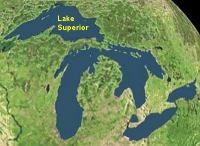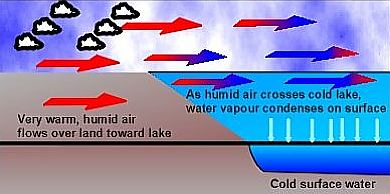 |
 |
| Home | Welcome | What's New | Site Map | Glossary | Weather Doctor Amazon Store | Book Store | Accolades | Email Us |
 | |||||||||
Superior Moisture GainLarge water bodies have major influences on the weather, the larger the water body, the larger the sphere of influence with the oceans playing a dominant global role. Water bodies impact the weather and climate of their shoreline regions as well: moderating seasonal extremes, increasing the likelihood of cloud or fog formation, causing shoreline wind regimes, and affecting precipitation. But unless we are involved with the maritime industry or sport sailing, we tend to overlook the weather and climate over the water body itself. I do not intend to delve into a general discussion of water/weather interactions here. Rather, I will look specifically at one aspect — condensation — and one specific water body — Lake Superior.  Lake Superior Lake Superior is the largest of the American Great Lakes and the world's second largest lake behind the Caspian Sea. However, Superior has the largest surface area of any freshwater lake in the world (the Caspian is salty). Because of its large size, depth and northern location, the temperature of its surface waters changes slowly with the seasons. Following a winter of intense cooling, Superior's waters take a long time to reheat during spring and summer and never reach the peak land temperatures of its surrounding basin. Excluding the shallower waters, most of Lake Superior's surface water does not climb much above 13oC (55o F) all summer long. While the lake's waters remain very cool, the air moving across it during the spring and summer can be very warm, even hot, as humid tropical air from the Gulf of Mexico flows northward into the Lake Superior basin. When warm air flows over the cold water surface, it cools by contact and some mixing. That tropical Gulf air is very humid; its summer dew point temperature — a measure of its moisture content — is high, frequently 16oC (60o F) or more. The dew point temperature is important because when the air is cooled to this temperature, fog and dew will begin forming. (For more details on dew point, see Laying Some Groundwork-2: Humidity.) Anyone who sails on the Great Lakes knows that fog and haze are common in the summer months, and can become hazardous to boaters and mariners by reducing over-water visibility, even, at times, hiding thunderstorms.  Water vapour in moist air condenses over cold lakeLake DewWhat most of us do not consider is dew formation on the lake, though we may experience it forming on a boat deck. When cold lake waters cool the overriding humid air below its dew point, the water vapor in the air condenses and actually forms dew upon the lake surface. This is a similar process to that forming drops of water on your iced tea glass or cold soda can when you enjoy a cold, refreshing drink on hot, humid days. You don't see the dew forming on the lake surface like you do on the glass or when dew forms at night on grass and vehicles, because it is water lying on water. Nonetheless, it is there. The process is greatest in June and July when the difference between the lake's surface water temperature and the tropical Gulf air's dew point is smallest and thus the condensation potential is greatest. Researchers have calculated that the condensed water, or dewfall, forming on the surface of Lake Superior can add several centimetres/inches of water per month to the lake during the summer. The total amount of dewfall may be equivalent to the water gained through precipitation at this time of year: around 80 mm (3.1 inches) each summer month. If we assume 25 mm (an inch) of condensed moisture uniformly deposited over the whole 82,880 square kilometres (32,000 square miles) of lake surface, the water gain amounts to over 2 trillion liters (550 billion gallons). Now that is a Superior moisture gain! A similar process, of course, will occur over the other Great Lakes. particularly Lakes Huron and Michigan, but not to the amount deposited on Lake Superior. Because of the unique geography of eastern North America, the contribution of dewfall to lake water balances is likely the highest here, but the process can occur anywhere in the world where humid air flows over cold lakes. And if you don't think an inch of water means much on large lakes such as the Great Lakes, the United States Great Lakes Shipping Association has reported that for every inch of lost clearance due to low water in certain areas of the waterway, an international vessel can lose from 90-115 metric tons of cargo-carrying capacity, which can amount to revenue losses to $11,000 per day of operation. Written by
|
|||||||||
 |
To Purchase Notecard, |
Now Available! Order Today! | |
 |
 |
NEW! Now Available in the US! |
The BC Weather Book: |


